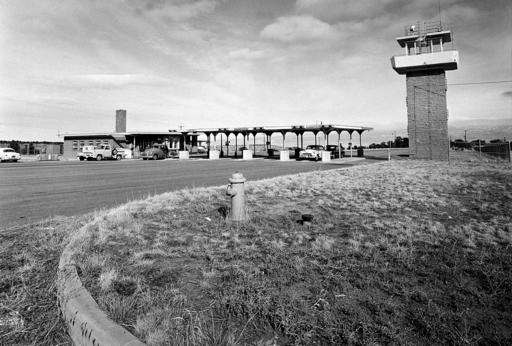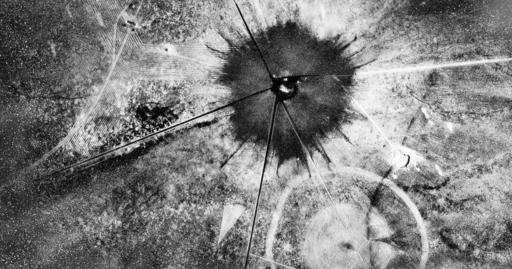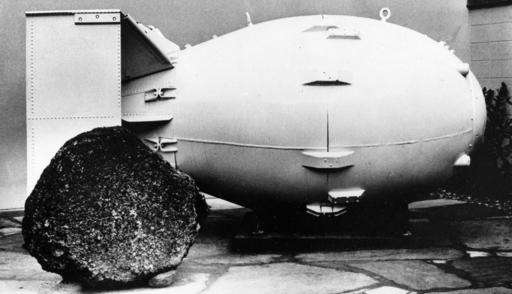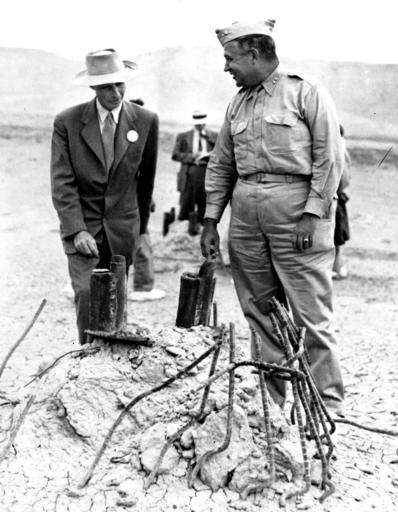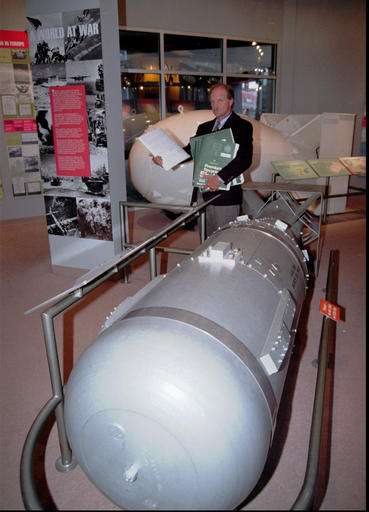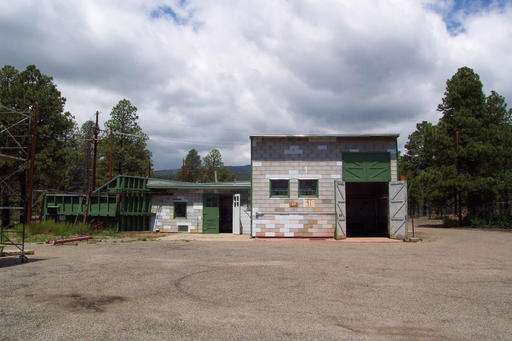This Feb. 25, 1955 file photo shows a general view of the main gate to the Los Alamos National Laboratory, in Los Alamos, N. M., where scientists developed and tested the first atomic weapon. During the Manhattan Project, Los Alamos scientists worked to develop the atomic bomb that was dropped on the Japanese cities of Hiroshima and Nagasaki. The program also involved facilities in Oak Ridge, Tennessee, and Hanford, Washington. (AP Photo/File)
Los Alamos, a once secret city where scientists participated in the nation's classified World War II nuclear development program, can now be experienced much like it was then with a new app.
The "Los Alamos: The Secret City of The Manhattan Project" iPhone app takes users through an "augmented-reality" while visiting the northern New Mexico city to see it in its 1940s character. The app was created by Los Alamos National Laboratory.
Packed with games, historical nuggets and role playing, the app allows users to feel what it was like to join a secret project in an unknown location where the future of the world was at stake, said Jennifer Payne, Resource Management Team leader in Los Alamos' Environmental Stewardship Group. Because Los Alamos has changed since the project and is now a modern city, Payne said the app takes users on a virtual tour of a Manhattan Project world that is gone.
"It took us more than a year to create," Payne said. "Almost all of the structures from that era don't exist anymore."
Once downloaded and opened, users will receive a "recruitment telegram" to begin the virtual journey from 109 E. Palace Ave., in Santa Fe. That's the same location where the original Project Y staff members joined the team. Users then will receive an initial "clearance" there, then board a bus into the mountains to explore "the Hill."
This July 16, 1945, file photo, shows an aerial view after the first atomic explosion at the Trinity Test site, in New Mexico. Residents of Tularosa, an historic Hispanic village located next to the Trinity Test site, are praising President Obama's plan to visit Hiroshima the Japanese city where the U.S. dropped an atomic bomb. July marks the 71st anniversary of the Trinity Test in southern New Mexico. The milestone comes amid renewed interest in the Manhattan Project thanks to new books, online video testimonies and recently canceled TV drama series "Manhattan." The secretive World War II program provided enriched uranium for the atomic bomb. (AP Photo/File)
From there, Payne said users can choose how much information they want to know while they explore Los Alamos as the bomb is developed.
Of course, no actual nuclear secrets are shared, she said.
Officials said the project is a collaboration of Los Alamos National Laboratory's VISIBLE team, the Bradbury Science Museum, and staff history specialists.
This Oct. 15, 1965, file photo shows a "Fat Man" nuclear bomb of the type tested at Trinity Site, N.M, and dropped on Nagasaki, Japan in 1945, on view for the public at the Los Alamos Scientific Laboratory Museum. Thursday, July 16, 2015 marks the 70th anniversary of the Trinity Test in southern N.M.July marks the 71st anniversary of the Trinity Test in southern New Mexico. The milestone comes amid renewed interest in the Manhattan Project thanks to new books, online video testimonies and recently canceled TV drama series "Manhattan." (AP Photo, File)
Developers also are working on an Android app.
During World War II, Los Alamos scientists worked to develop the atomic bomb that was dropped on the Japanese cities of Hiroshima and Nagasaki. The secret program provided enriched uranium for the atomic bomb. It also involved facilities in Oak Ridge, Tennessee, and Hanford, Washington.
July marks the 71st anniversary of the Trinity Test in southern New Mexico. The milestone comes amid renewed interest in the Manhattan Project thanks to new books, online video testimonies and the recently canceled TV drama series "Manhattan."
-
This Sept. 9, 1945, file photo Gen. Leslie R. Groves, right, and Dr. J. Robert Oppenheimer, who cooperated on the development of the atomic bomb, survey the area in Alamogordo, N.M., where a tower once stood before the test bomb exploded. A new PBS special looks into the creation of the atomic bomb in the city of Los Alamos and will feature newly-restored footage of nuclear weaponry. "The Bomb," which begins airing Tuesday, July 28, 2015, on most PBS stations, seeks to tell the story of the deadly device as the 70th anniversary of the atomic bombings of Hiroshima and Nagasaki approaches. (AP Photo/File)
-
In this April 18, 1997, file photo, John Rhoades, director of The Bradbury Science Museum at Los Alamos National Laboratory, holds one of 11 public comment books at Los Alamos, N.M. The books suggest that almost none of the thousands of people writing comments were aware of Japanese efforts to build an atomic bomb during World War II, but most either favored or opposed the U.S. decision to drop atomic bombs on Japan. In foreground is mockup of "Little Boy," the bomb dropped Aug. 6, 1945, on Hiroshima. In background is mockup of "Fat Man," the bomb dropped Aug. 9, 1945, on Nagasaki. (AP Photo/Al Cabral, File)
-
This undated photo provided by the Atomic Heritage Foundation shows the "high bay" building at Los Alamos National Laboratory in Los Alamos, N.M. The building was part of V Site, a collection of wooden, shed-type structures that were slated for demolition as part of a cleanup at Los Alamos National Laboratory until preservationists jumped in. In 2000, the Cerro Grande fire swept through, destroying all but the high bay building. The simple structure, the first Manhattan Project work site to be restored, is a reminder of the urgency with which scientists gathered in 1944 to design and assemble the first atomic weapons. (Los Alamos National Laboratory via Atomic Heritage Museum via AP, File)
© 2016 The Associated Press. All rights reserved.
